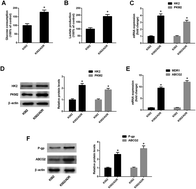Our official English website, www.x-mol.net, welcomes your feedback! (Note: you will need to create a separate account there.)
Artesunate enhances adriamycin cytotoxicity by inhibiting glycolysis in adriamycin-resistant chronic myeloid leukemia K562/ADR cells
RSC Advances ( IF 3.9 ) Pub Date : 2019-01-09 00:00:00 , DOI: 10.1039/c8ra08041k Li Chen 1 , Chao Wang 1 , Ning Hu 1 , Hongmian Zhao 1
RSC Advances ( IF 3.9 ) Pub Date : 2019-01-09 00:00:00 , DOI: 10.1039/c8ra08041k Li Chen 1 , Chao Wang 1 , Ning Hu 1 , Hongmian Zhao 1
Affiliation

|
Adriamycin (ADR) is a widely used drug in multiple cancers including leukemia. Artesunate (ART) has been reported to improve the cytotoxicity of some chemotherapeutic drugs in cancers. However, it is still unknown whether ART can augment the cytotoxicity of ADR in ADR-resistant K562 leukemia cells (K562/ADR). Glycolytic activity was assessed by detecting glucose consumption, lactate production and glycolysis-related enzymes. MDR1 and ABCG2 mRNA levels were measured by RT-qPCR. Protein levels of P-glycoprotein (P-gp), ABCG2 and cytochrome c (Cyt c) were determined by western blot assay. Cell apoptosis was evaluated by flow cytometry. Cell viability was examined by CCK-8 assay. The results showed that K562/ADR cells exhibited increased glycolytic activity and mdr1 and abcg2 gene expression. ART potentiated ADR cytotoxicity in K562 and K562/ADR cells. Moreover, ART reversed ADR-induced mdr1 and abcg2 gene expression and inhibited P-gp and ABCG2 activities in K562/ADR cells. ART potentiated ADR-mediated inhibition on glycolysis in K562 and K562/ADR cells. Inhibition of glycolysis reduced cell viability, downregulated the expression of mdr1 and abcg2 genes, and induced cell apoptosis in K562/ADR cells. Overall, the results indicated that ART enhanced ADR cytotoxicity by inhibiting glycolysis and reducing mdr1 and abcg2 gene expression in K562/ADR cells, providing a deep insight into the function and molecular basis of ART in regulating MDR in leukemia cells and hinting at the potential values of ART in alleviating MDR in cancers.
中文翻译:

青蒿琥酯通过抑制阿霉素耐药的慢性髓细胞白血病 K562/ADR 细胞的糖酵解增强阿霉素的细胞毒性
阿霉素(ADR)是一种广泛用于治疗包括白血病在内的多种癌症的药物。据报道,青蒿琥酯 (ART) 可改善某些化疗药物在癌症中的细胞毒性。然而,ART 能否增强 ADR 对 ADR 耐药的 K562 白血病细胞 (K562/ADR) 的细胞毒性仍不清楚。通过检测葡萄糖消耗、乳酸产生和糖酵解相关酶来评估糖酵解活性。通过 RT-qPCR 测量 MDR1 和 ABCG2 mRNA 水平。P-糖蛋白 (P-gp)、ABCG2 和细胞色素c (Cyt c ) 的蛋白质水平通过蛋白质印迹法测定。通过流式细胞术评估细胞凋亡。通过CCK-8测定检查细胞活力。结果表明,K562/ADR 细胞表现出增加的糖酵解活性和mdr1和abcg2基因表达。ART 增强了 K562 和 K562/ADR 细胞中的 ADR 细胞毒性。此外,ART 逆转 ADR 诱导的mdr1和abcg2基因表达,并抑制 K562/ADR 细胞中 P-gp 和 ABCG2 的活性。ART 增强了 ADR 介导的对 K562 和 K562/ADR 细胞中糖酵解的抑制作用。在 K562/ADR 细胞中,糖酵解的抑制降低了细胞活力,下调了mdr1和abcg2基因的表达,并诱导了细胞凋亡。总体而言,结果表明 ART 通过抑制糖酵解和减少mdr1和abcg2来增强 ADR 细胞毒性K562/ADR 细胞中的基因表达,深入了解 ART 在调节白血病细胞 MDR 中的功能和分子基础,并暗示 ART 在减轻癌症 MDR 中的潜在价值。
更新日期:2019-01-09
中文翻译:

青蒿琥酯通过抑制阿霉素耐药的慢性髓细胞白血病 K562/ADR 细胞的糖酵解增强阿霉素的细胞毒性
阿霉素(ADR)是一种广泛用于治疗包括白血病在内的多种癌症的药物。据报道,青蒿琥酯 (ART) 可改善某些化疗药物在癌症中的细胞毒性。然而,ART 能否增强 ADR 对 ADR 耐药的 K562 白血病细胞 (K562/ADR) 的细胞毒性仍不清楚。通过检测葡萄糖消耗、乳酸产生和糖酵解相关酶来评估糖酵解活性。通过 RT-qPCR 测量 MDR1 和 ABCG2 mRNA 水平。P-糖蛋白 (P-gp)、ABCG2 和细胞色素c (Cyt c ) 的蛋白质水平通过蛋白质印迹法测定。通过流式细胞术评估细胞凋亡。通过CCK-8测定检查细胞活力。结果表明,K562/ADR 细胞表现出增加的糖酵解活性和mdr1和abcg2基因表达。ART 增强了 K562 和 K562/ADR 细胞中的 ADR 细胞毒性。此外,ART 逆转 ADR 诱导的mdr1和abcg2基因表达,并抑制 K562/ADR 细胞中 P-gp 和 ABCG2 的活性。ART 增强了 ADR 介导的对 K562 和 K562/ADR 细胞中糖酵解的抑制作用。在 K562/ADR 细胞中,糖酵解的抑制降低了细胞活力,下调了mdr1和abcg2基因的表达,并诱导了细胞凋亡。总体而言,结果表明 ART 通过抑制糖酵解和减少mdr1和abcg2来增强 ADR 细胞毒性K562/ADR 细胞中的基因表达,深入了解 ART 在调节白血病细胞 MDR 中的功能和分子基础,并暗示 ART 在减轻癌症 MDR 中的潜在价值。






































 京公网安备 11010802027423号
京公网安备 11010802027423号